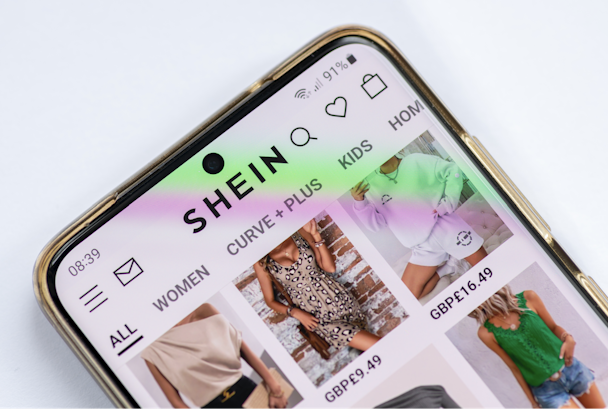Can Shein shift from bargain bin to legitimate fashion player?
The controversial Chinese fast fashion retailer has been cleaning up its image. Ahead of its IPO, we ask marketers if Shein has built a legitimate brand.

Inside Shein's bid for IPO / AdobeStock
Shein is in the process of taking the Chinese-founded business public on the New York Stock Exchange, its initial public offering a significant moment for the e-commerce giant.
Selling trending fashion, homeware and beauty for prices as low as £1, Shein has built a mega brand most recently valued at $66bn. The retailer is poised to overtake both H&M and Zara in revenue, according to a report by The Wall Street Journal.
Shein’s phenomenal global growth is often credited to its social media strategy and its low prices. As Dena Walker, strategy director at creative agency Above+Beyond, explains: “Social media in China has been inextricably linked to commerce for well over a decade and it breaks into two core pillars that older, more established brands in the west have been slow to pivot to because they’re encumbered by legacy operations. Essentially, what Shein has done to blow up the usual model is to tap into the power of the herd effect while data-mining for insights that scale and fuel that herd effect further.”
Advertisement
Despite its rapid assent, Shein has struggled with its reputation since its 2008 launch. It has previously been dubbed the “most manipulative” fashion website, according to a report by Rouge Media that counted eight instances of dark patterns on its site. It has received numerous high-profile criticisms about its workforce conditions and environmental impact and, in 2022, was forced to invest $15m to improve its supply chain.
But Shein has been making moves to legitimize itself within the fashion world. In October, the retailer bought the Misguided brand name from the Frasers Group and has recently partnered with the likes of Forever 21, Paul Smith and luxury footwear maker Stuart Weitzman.
Advertisement
TikTok hauls and celeb parternships
Shein’s TikTok account is followed by a staggering 8.8 million people (fellow retailer Forever 21 has just 217,000 and H&M has 416,000) while the hashtag #Shein has an eyewatering 82.9bn views (#Zara has just 28.3bn).
Zara Ineson, the former executive creative director at House 337, credits these numbers to the brand’s “big bang newsworthy partnerships and collaborations at a top level, which are supported with a vast micro influencer drumbeat that creates a sea of localized TikTok fans, who work for free hauls and commissions, to beat the social algorithm.”
Unlike the majority of its British fast fashion competitors, Shein doesn’t spread its bets with a wide target audience, explains Ineson. Shein has worked with celebrities including Katy Perry, Lil Nas X, Hailey Bieber, Jenna Lyons and the Kardashians, for example. Its marketing activity is “fast and frequent.”
“Its approach to brand fame is not rocket science, but it’s directed towards a supremely focussed audience; it’s real-time moving at the pace of culture, backed by big cash and, my gosh, it bloody well works.”
Suggested newsletters for you
Is Shein’s marketing for the IPO or the customer?
Out-of-home is another place Shein plays, along with experience marketing. Last year, it opened a series of pop-up shops across Europe, including two days on London’s Oxford Street that featured a beauty bar along with selling clothing and homeware products.
Ella Britton, who is strategy director at behavioural consultancy Behave, says these activities are hallmarks of established high street retailers. “It is doing a lot of stuff that’s synonymous with higher quality fashion brands, which is very deliberate in terms of building quality by association,” she says. “But if you go on its website, it’s still very much tat.”
Because of its pricing, customers aren’t expecting Shein to improve its website in the same way they expect other brands to. “But once it gets people in, it’s hook, line and sinker,” says Britton. Shein’s “genius” marketing moves are “incredibly deliberate” due to the news of the IPO, she adds.
Price trumps ethics in cost of living crisis
The cost of living crisis has contributed to Shein’s growth over the past few years, explains Juan Pellerano-Rendón, chief marketing officer at e-commerce returns platform Swap. Clothing is the easiest place to cut back, he says.
The timing of Shein’s IPO is at odds with recent National Retail Federation research that found 80% of shoppers want to buy from sustainable brands, he adds.
“We’re in a very tumultuous state of the world where I think people care about the environment but have their minds in a lot of other places. There is always going to be fast fashion in fashion because there is always going to be someone who is price sensitive.”

